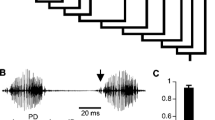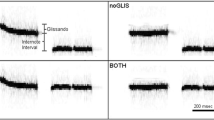Summary
-
1.
The calling song of the male cricket Scapsipedus marginatus consists of a long series of chirps. Each chirp consists of 4–6 sound pulses separated by alternating shorter and longer intervals (Fig. 3). The dominant frequency of the song is approximately 5 kHz (Fig. 6) and the chirp interval is 1.6 sec (Fig. 4).
-
2.
As measured by the ability of conspecific females to locate the sound source when they are allowed to respond by freely walking, the pulse interval pattern is the only species-specific characteristic of theS. marginatus calling song. The other characteristics of the song-chirp interval, fundamental frequency, number of pulses per chirp-may be severely altered without affecting the phonotactic response, e.g. the phonotactic response is elicited by an artificial song with the specific pulse pattern but with fundamental frequency of 18 kHz (Fig. 7).
-
3.
The phonotactic response to continuous stimulation by natural calling song is characterized by short-term changes: an initial period of arousal followed by a highly active steady state which declines after a short period (Fig. 11).
-
4.
A non-specific stimulus, the calling song of a sympatric species will elicit locomotion in female crickets. The initial incremental period before locomotion begins is significantly greater than that which occurs when the stimulus is the species-specific calling song (Fig. 12).
-
5.
Although motor output (walking) can be driven by non-specific acoustical stimuli, the species-specific sensory input is required for locomotion to be directed to the sound source.
Similar content being viewed by others
References
Alexander, R. D.: Acoustical communication in arthropods. Ann. Rev. Entomol.12, 495–526 (1967).
Busnel, R. C., Dumortier, B., Pasquinelly, F.: Phonotaxie de ♀ d'Ephippiger (Orthoptère) à des signaux acoustique synthétiques. C. R. Soc. Biol. (Paris)149, 11–13 (1955).
Busnel, R. G., Loher, W., Pasquinelly, F.: Recherches sur les signaux acoustiques synthétiques réactogenes pour divers Acrididae ♂. C. R. Soc. Biol. (Paris)148, 1987–1991 (1954).
Hinde, R.A.: Behavioral habituation. In: Short-term changes in neural activity and behavior, eds. G. Horn and R. A. Hinde. Cambridge University Press 1970.
Horridge, G. A.: Pitch discrimination in locust. Proc. roy. Soc. B155, 218–231 (1961).
Johnstone, B. M., Saunders, J. C., Johnstone, R. J.: Tympanic membrane response in the cricket. Nature (Lond.)227, 625–626 (1970).
Katsuki, Y., Suga, N.: Neural mechanisms of hearing in insects. J. exp. Biol.37, 279–290 (1960).
Michelsen, A.: Pitch discrimination in the locust ear: observations on single sense cells. J. Insect. Physiol.12, 1119–1131 (1966).
Michelsen, A.: The physiology of the locust ear. Z. vergl. Physiol.71, 49–128 (1971).
Murphey. R. K., Zaretsky, M. D.: Orientation to calling song by female cricketsScapsipedus marginatus (Gryllidae). J. exp. Biol.56, 335–352 (1972).
Nocke, H.: Physiological aspects of sound communication in crickets,Gryllus campestris (Gryllidae). J. comp. Physiol. In the press (1972).
Nottebohm, P.: The role of sensory feedback in the development of avian vocalizations. Proc. XlVth Int. Ornith. Congr. (ed. D. W. Snow) p. 268–280. Oxford: Blackwell Publications (1967).
Popov, A. V.: Electrophysiological studies of the peripheral neurons of the auditory system in the locust [translated from Russian]. Zhurnal Evolyutsionnoi Biok- himmi i Fiziologiyi1, 239–250 (1965).
Popov, A. V.: Synaptic transformation in the auditory system of insects. In: Sensory processes at the neuronal and behavioral level. New York: Academic Press 1971.
Regen, J.: Über die Anlockung des Weibchens vonGryllus campestris L. durch telephonisch übertragene Stridulationslaute des Männchens. Pflügers Arch. ges. Physiol.155, 193–200 (1913).
Roeder, K. D.: Auditory system of noctuid moths. Science154, 1515–1521 (1966).
Roeder, K. D.: Nerve cells and insect behavior, 2nd ed. Cambridge, Mass: Harvard University Press 1967.
Roeder, K. D.: Episodes in insect brains. Amer. Scientist58, 378–389 (1970).
Roeder, K. D. Treat, A. E.: Ultrasonic reception by the tympanic organ of noctuid moths. J. exp. Zool.134, 127–157 (1957).
Siegel, S.: Non-parametric statistics. New York: McGraw-Hill 1956.
Walker, T. J. Jr.: Specificity in the response of female tree crickets (Orthoptera, Gryllidae,Oecanthidae) to calling songs of the males. Ann. entomol. Soc. Amer.50, 626–636 (1957).
Wilson, D. M.: Inherent asymmetry and reflex modulation of the locust flight motor pattern. J. exp. Biol.48, 631–641 (1968).
Zaretsky, M. D.: Patterned response to song in cricket central auditory neurons. Nature (Lond.)229 195–196 (1971).
Zaretsky, M. D.: Frequency discrimination in the ear of the cricket,Scapsipedus marginatus (Gryllidae). In preparation (1972a).
Zaretsky, M. D.: The central auditory neurons of the cricketScapsipedus marginatus (Gryllidae). In preparation (1972b).
Author information
Authors and Affiliations
Rights and permissions
About this article
Cite this article
Zaretsky, M.D. Specificity of the calling song and short term changes in the phonotactic response by female cricketsScapsipedus marginatus (Gryllidae). J. Comp. Physiol. 79, 153–172 (1972). https://doi.org/10.1007/BF00697769
Received:
Issue Date:
DOI: https://doi.org/10.1007/BF00697769




